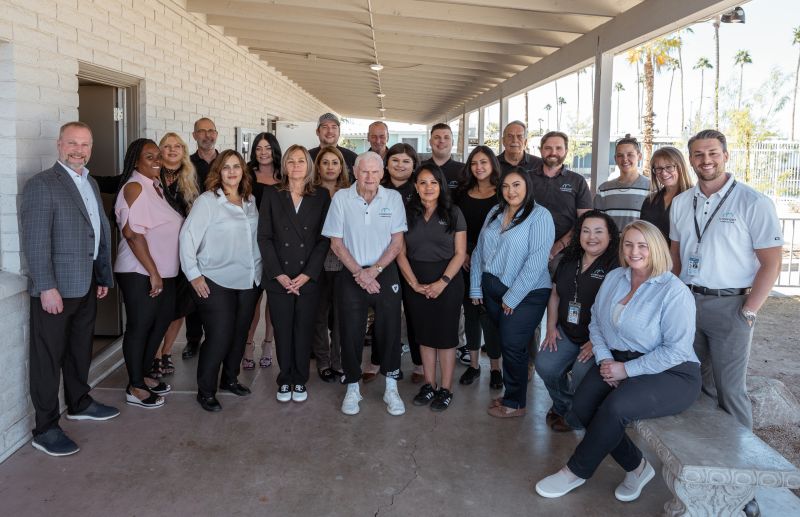Newsletter: March 2025
Spring is officially here—and with it comes fresh momentum. The days are getting longer, the weather’s warming up, and there’s a renewed sense of possibility in the air. Whether you’re tackling new projects or simply enjoying the change in season, we’re excited for what this next chapter brings.
This month, I’ll cover:
- Why being a landlord in California is getting harder
- The stock market sell-off we witnessed a couple weeks ago
- Treasury yields continuing to dip
- The potential for 100% bonus depreciation in 2025
- Comfort Communities on-site team training
- Center Point fully subscribed
- Be a guest speaker on CashFlow Quest
Why Being a Landlord in California is Getting Harder
Lately, I’ve had a lot of conversations with clients about the challenges of being a landlord in California. It usually starts with skyrocketing insurance premiums—or worse, getting dropped and scrambling for a new provider. Then there’s the constant expense creep from HVAC, new windows, roofing, and general maintenance, made worse by inflation. Add in the horror stories about unruly tenants, under-rented units, and distant family members asking for a discount because “you obviously can afford it.” It usually ends with me running some back-of-the-envelope math and realizing they’re only generating 2–3% cash-on-cash returns on their equity after expenses—all while doing three times the work.
The common defense is California’s historical appreciation, which is valid—but at what cost? For many, the returns have already been made and the ongoing hassle of dealing with tenants, repairs, legal exposure, and rising expenses outweighs the future benefits.
Now, insurance issues are making headlines daily. A recent Wall Street Journal piece highlighted how over 5,000 condo complexes—mostly in California and Florida—are blacklisted from Fannie and Freddie loans, making it nearly impossible to sell or finance those properties. Talk to 5 people about their insurance and you will hear 3 stories about how they’ve gone up or have been dropped. Ask any honest landlord about their rentals and you’ll hear about at least one property they would love to get rid of.
For those who’ve already benefited from California’s real estate boom, now might be the time to reinvest those gains into a passive, cash-flowing investment out of state—like what we offer at Comfort. At the end of the day, we invest in real estate—either personally or passively—to increase our net worth, receive tax benefits, and generate monthly cash flow, all of which you still get by investing with us. This isn’t a sales pitch; it’s a reality check. There’s a way out, and we’re here to help.
The Stock Market Sell-Off: A Dip & An Opportunity
The stock market has hit a rough patch lately, pulling back from its all-time highs and leaving investors on edge. As of mid-March 2025, the major indices have experienced a notable sell-off, with the Nasdaq 100 officially entering correction territory—down more than 10% from its peak. The S&P 500, while not yet in a formal correction, has also shed significant ground, declining roughly 8-10% from its record high set late last year, depending on the exact day you measure. A mix of factors has driven this downturn: uncertainty over Federal Reserve policy, shifting investor sentiment, tariff concerns, and broader economic concerns. For stock holders, it’s been a jolting reminder that even the most bullish runs don’t last forever.
But while stocks stumble, a silver lining is emerging elsewhere—particularly for those in the real estate game. Treasury yields, which play a pivotal role for us in determining borrowing costs, have been trending downward, creating a favorable environment for property investors. Let’s break down what’s happening and why now might be a golden moment to strike in real estate.
Treasury Yields Drop: A Real Estate Boom
Here’s where things get interesting. After peaking near 4.8% in mid-January, the 10-year Treasury yield has tumbled, falling about 60 basis points to hover around 4.2% as of mid-March 2025. In fact, we just rate locked our latest deal, Center Point at an all-in fixed rate of 5.3% (interest only!) for 10 years – an amazing rate in today’s environment. This decline is a game-changer for real estate. Why? Because Treasury yields are the benchmark for borrowing costs across the economy, especially for mortgages and commercial loans. When yields drop, debt gets cheaper—and in real estate, where leverage is king, cheaper debt can supercharge deals.
The Bottom Line
The stock market’s recent sell-off—down 8-10% for the S&P 500 and over 10% for the Nasdaq from their peaks—has rattled cages and personally speaking, I think it could get worse before it gets better. But it’s not all doom and gloom. For real estate players, the drop in Treasury yields is a gift. Cheaper debt means more room to maneuver, whether you’re buying, building, or holding. While equity investors lick their wounds, this could be our moment to pounce. Markets ebb and flow, but right now, the tide’s turning in favor of bricks and mortar. While investors might see red on their screens when checking their brokerage accounts, our portfolio has never been stronger and we are seeing large gains in net operating income across our portfolio and are poised to continue to increase distribution yields to investors in 2025.
Investor Update: Trump Tax Bill & the Return of 100% Bonus Depreciation – Where Things Stand
As we move through Q1 2025, we want to share a timely update on a significant policy development that could impact our real estate investment strategies and our investor’s tax savings: the proposed reinstatement of 100% bonus depreciation as part of President Trump’s broader tax reform agenda.
What Is 100% Bonus Depreciation?
Bonus depreciation allows businesses and real estate owners to immediately deduct a percentage of the cost of qualifying assets—such as equipment, machinery, and property improvements—in the year they’re placed in service, rather than depreciating them over time.
This incentive was a major feature of the 2017 Tax Cuts and Jobs Act (TCJA), which allowed for 100% bonus depreciation from 2018 to 2022. It began phasing out in 2023 (dropping to 80%), and is scheduled to decline to 60% in 2024, 40% in 2025, and fully expire by 2027—unless Congress takes action.
President Trump has prioritized restoring 100% bonus depreciation, potentially making it permanent. The goal is to stimulate domestic investment, manufacturing, and economic growth.
Current Status: Gaining Momentum in Washington
Following Trump’s re-election and a Republican sweep of Congress (House majority and a 53-47 Senate), momentum is building. In his March 4th State of the Union, President Trump called for full expensing to be reinstated retroactively from January 1, 2025.
Republican leaders in Congress are reportedly drafting a reconciliation package—unofficially dubbed the “Trump Tax Bill 2.0”—that would include bonus depreciation, extensions of individual tax cuts from the TCJA, and potentially even the elimination of taxes on tips. Reconciliation allows passage with a simple Senate majority, avoiding the filibuster and paving the way for swift legislative action.
Key lawmakers, including House Ways and Means Chairman Jason Smith and Senate Finance Committee members, are targeting a late spring introduction with potential enactment before mid-year.
Why This Matters for Manufactured Housing Community (MHC) Investors
The impact of 100% bonus depreciation is especially powerful in the manufactured housing sector. Unlike many other real estate asset classes, 70–80% of a mobile home park’s purchase price can often be attributed to depreciable land improvements—such as roads, utility infrastructure, water and sewer systems, fencing, lighting, and signage.
Through cost segregation studies, these improvements can be broken out and depreciated over shorter lives (typically 5, 7, or 15 years). With 100% bonus depreciation in place, nearly all of these assets can be fully written off in the first year, dramatically reducing taxable income and significantly improving after-tax returns for investors.
Here’s a simplified breakdown:
- A $1 million investment into a new MHC in 2025 could generate $700,000–$800,000+ in first-year paper losses, which can offset other passive income (and potentially active income, depending on the investor’s tax status).
- Leverage (debt) amplifies the benefit: by financing a portion of the acquisition with debt, investors can control a larger asset with less equity. From our historical experience, this often results in a 1:1 first-year write-off relative to invested equity—a significant advantage when combined with cost segregation and 100% bonus depreciation.
- These losses enhance cash-on-cash returns and allow for more tax-efficient wealth building.
What It Means for Our Investors
We’re actively modeling all new 2025 acquisitions using a conservative 40% depreciation assumption for 2025, with upside potential if 100% bonus depreciation is reinstated. If passed retroactively, properties like Casa Piena and Center Point could generate substantial year-one tax benefits for investors participating in 2025 deals. Even if the policy isn’t retroactive (my personal belief is that it will be), a mid-year reinstatement would still benefit acquisitions made in the second half of 2025 and inform strategic planning for 2026.
We’ll keep you informed as this legislation evolves. As always, we’re focused on positioning your investments to take full advantage of emerging opportunities.
Comfort Communities On-Site Training Day

Late February marked a milestone for the Comfort Communities team as we hosted our first in-person staff training with our Property Management crew in Phoenix, bringing together team members from Tucson, Yuma, San Diego, and Texas.
The focus? “Comfort Hospitality”—our heartbeat as a company—along with our culture and the key touchpoints that define our communities: resident relations, vendor partnerships, park aesthetics, resident resources, and communication. We believe how we treat one another sets the tone for how we impact our residents. It was a day of getting back to the basics—our bread and butter—and doing it right.
